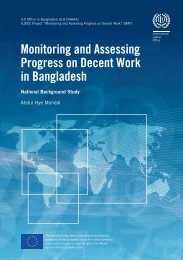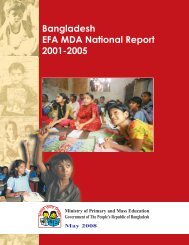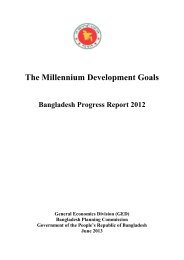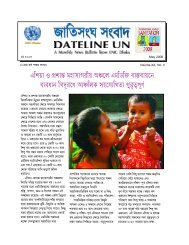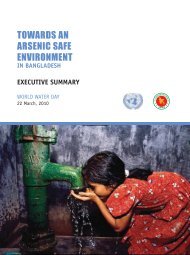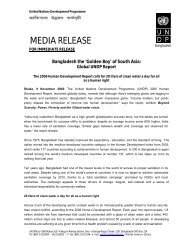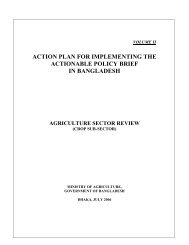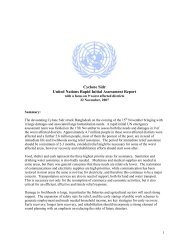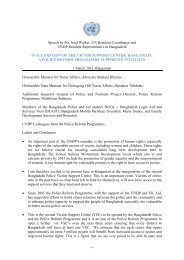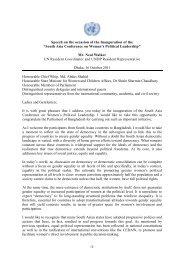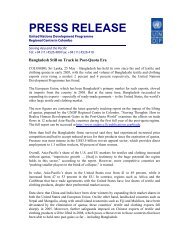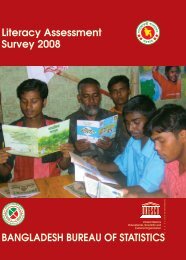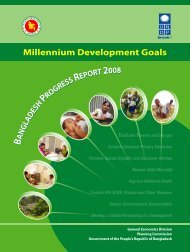Database - United Nations in Bangladesh
Database - United Nations in Bangladesh
Database - United Nations in Bangladesh
Create successful ePaper yourself
Turn your PDF publications into a flip-book with our unique Google optimized e-Paper software.
82 People's Report 2002-2003 : <strong>Bangladesh</strong> Environment<br />
Table 3.2.6 Different Breeds of Livestock and Poultry Birds <strong>in</strong> <strong>Bangladesh</strong><br />
1. Cattle<br />
Breeds: (a) Local : Nondescript <strong>in</strong>digenous type, Red Chittagong, Goyal and Pabna<br />
cows<br />
2. Buffalo<br />
Breeds:<br />
3. Goat<br />
Breeds:<br />
4. Sheep<br />
(b) Exotic :<br />
(c) Hybrid :<br />
(a) River type<br />
(b) Swamp type<br />
(c) River X Swamp type<br />
(a) Black Bengal<br />
(b) Jamna pari<br />
(c) Cross-bred; Black<br />
Bengal X Jamna pari<br />
Hariana, S<strong>in</strong>dhi, Sahiwal, Jersey and Holste<strong>in</strong> Friesian<br />
Bos <strong>in</strong>dicus X Bos taurus<br />
Bos <strong>in</strong>dicus X Box frontalis<br />
5. Pig<br />
6. Poultry<br />
7. Duck<br />
Source: FAO (2001)<br />
Nondescript <strong>in</strong>digenous type<br />
Nondescript <strong>in</strong>digenous type<br />
Breeds: (a) Local : Nondescript <strong>in</strong>digenous type, Asseel Chittagong fowl and<br />
Nacked neck<br />
(b) Exotic : White laghorn, Rbode Island Red Fayoumi, Australorp, and a<br />
number of commercial broiler and layer breeds.<br />
(c) Cross-bred:<br />
Indigenous X Exotic<br />
Breeds: (a) Local : Nondescript <strong>in</strong>digenous type, Sylhet mete, Nagashari, Muscove,<br />
Goose<br />
(b) Exotic : Khaki Campbell, Indian Runner, Jund<strong>in</strong>g, Cherry Valley<br />
(c) Cross-bred:<br />
Indigenous X Exotic<br />
Table 3.2.7 Production, Requirements and Deficits of Livestock Products<br />
Products<br />
Per Capita need<br />
Per Capita Total Need Total Total Deficit<br />
Availability (Year) Production (Year)<br />
Milk 250 ml/day 33.95 ml/day<br />
Meat (all) 120 gm/day 12.61gm/day<br />
Eggs 2/week 0.455/week<br />
9.855 mmt 1.338 mmt 8.517 mmt<br />
(100%) (13.58%) (86.42%)<br />
4.257 mmt 0.447 mmt 3.81 mmt<br />
(100%) (10.50%) (89.50)<br />
8985.6 mn 2046.53 mn 6939.07<br />
(100%) (22.78%) (77.22%)<br />
Source : Alam (1992)<br />
Note : 1. mmt = million metric ton. 2. mn = million number.<br />
3. The deficit <strong>in</strong> meat is calculated assum<strong>in</strong>g all meat com<strong>in</strong>g from livestock sources. Assum<strong>in</strong>g 50% animal prote<strong>in</strong><br />
to be supplied by the fishery sector, the net deficit <strong>in</strong> meat comes down to 78.94%.<br />
4. Population <strong>in</strong> 1991 = 108 million.<br />
5. Total requirements for meat and eggs are calculated mak<strong>in</strong>g a deduction of 10% and 20% respectively from total population.



